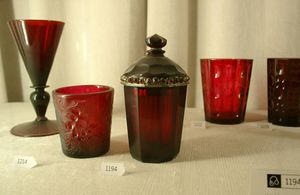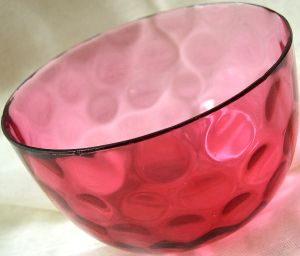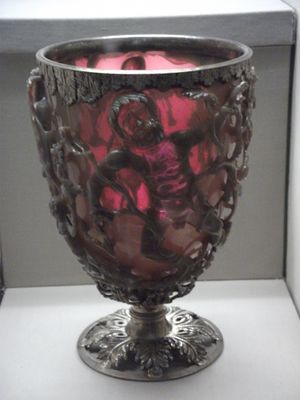زجاج ياقوت الذهب

زجاج ياقوت الذهب ملاحظة 1 هو نوع من أنواع الزجاج الأحمر الذي يحصل عليه من إضافة أملاح الذهب أو الذهب الغرواني إلى مصهور الزجاج أثناء تشكيله.
يستخدم زجاج ياقوت الذهب يشكل أساسي في التزيين وفي صناعة حاجيات الزينة.
الإنتاج
عادة ما ينتج زجاج ياقوت الذهب في الحرف اليدوية بدل إنتاجه آلياً بكميات كبيرة، وذلك بسبب ارتفاع سعر الذهب.[1]
يستخدم ملح كلوريد الذهب إما جاهزاً أو بإذابة الذهب في الماء الملكي؛ وقد يضاف كلوريد القصديروز بكميات صغيرة كمختزل.
التاريخ
The origins of cranberry glass making are unknown, but many historians believe a form of this glass was first made in the late Roman Empire. This is evidenced by the British Museum's collection Lycurgus Cup, a 4th-century Roman glass cage cup made of a dichroic glass, which shows a different colour depending on whether light is passing through it or reflecting from it; red (gold salts) when lit from behind and green (silver salts) when lit from in front.[2][3]
The craft was then lost and rediscovered in the 17th century Bohemian period by either Johann Kunckel in Potsdam or by the Florentine glassmaker Antonio Neri in Italy. Neither of them knew the mechanism which yielded the colour, however. Chemist and winner of the 1925 Nobel Prize in Chemistry Richard Adolf Zsigmondy was able to understand and explain that small colloids of gold were responsible for the red colour.
هوامش
ملاحظة 1 زجاج ياقوت الذهب (Gold Ruby Glass) يعرف أيضاً باسم زجاج التوت البري الأحمر Cranberry glass.
مراجع
- ^ Cooper, R., Dornbusch, R., & Hall, R (1982). "The Gold Standard: Historical Facts and Future Prospects": 1–56.
{{cite journal}}: Cite journal requires|journal=(help)CS1 maint: multiple names: authors list (link) - ^ Freestone, Meeks, Sax & Higgitt (2007). British Museum Highlights. pp. 270–273.
{{cite book}}: CS1 maint: multiple names: authors list (link) - ^ "OPTICAL METAMATERIALS : Invisibility cup" (PDF). Cobweb.ecn.purdue.edu. Retrieved 2016-11-29.
وصلات خارجية
- Wiggins, Pamela. "Learn About Antique and Collectible Cranberry Glass". Antiques.about.com. Retrieved 2016-11-29.
- "Family Treasures 9". Laterlife.com. Retrieved 2016-11-29.
- "Gold Ruby Glass from Gibraltar". Glass.co.nz. Retrieved 2016-11-29.

